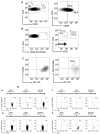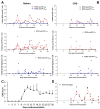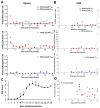Dynamic cross-regulation of antigen-specific effector and regulatory T cell subpopulations and microglia in brain autoimmunity
- PMID: 23618467
- PMCID: PMC3651362
- DOI: 10.1186/1752-0509-7-34
Dynamic cross-regulation of antigen-specific effector and regulatory T cell subpopulations and microglia in brain autoimmunity
Abstract
Background: Multiple Sclerosis (MS) is considered a T-cell-mediated autoimmune disease with a prototypical oscillatory behavior, as evidenced by the presence of clinical relapses. Understanding the dynamics of immune cells governing the course of MS, therefore, has many implications for immunotherapy. Here, we used flow cytometry to analyze the time-dependent behavior of antigen-specific effector (T(eff)) and regulatory (T(reg)) T cells and microglia in mice model of MS, Experimental Autoimmune Encephalomyelitis (EAE), and compared the observations with a mathematical cross-regulation model of T-cell dynamics in autoimmune disease.
Results: We found that T(eff) and T(reg) cells specific to myelin olygodendrocyte glycoprotein (MOG) developed coupled oscillatory dynamics with a 4- to 5-day period and decreasing amplitude that was always higher for the T(eff) populations, in agreement with the mathematical model. Microglia activation followed the oscillations of MOG-specific T(eff) cells in the secondary lymphoid organs, but they were activated before MOG-specific T-cell peaks in the CNS. Finally, we assessed the role of B-cell depletion induced by anti-CD20 therapy in the dynamics of T cells in an EAE model with more severe disease after therapy. We observed that B-cell depletion decreases T(eff) expansion, although its oscillatory behavior persists. However, the effect of B cell depletion was more significant in the T(reg) population within the CNS, which matched with activation of microglia and worsening of the disease. Mathematical modeling of T-cell cross-regulation after anti-CD20 therapy suggests that B-cell depletion may influence the dynamics of T cells by fine-tuning their activation.
Conclusions: The oscillatory dynamics of T-cells have an intrinsic origin in the physiological regulation of the adaptive immune response, which influences both disease phenotype and response to immunotherapy.
Figures






Similar articles
-
B-cell activation influences T-cell polarization and outcome of anti-CD20 B-cell depletion in central nervous system autoimmunity.Ann Neurol. 2010 Sep;68(3):369-83. doi: 10.1002/ana.22081. Ann Neurol. 2010. PMID: 20641064 Free PMC article.
-
A Spontaneous Model of Experimental Autoimmune Encephalomyelitis Provides Evidence of MOG-Specific B Cell Recruitment and Clonal Expansion.Front Immunol. 2022 Feb 3;13:755900. doi: 10.3389/fimmu.2022.755900. eCollection 2022. Front Immunol. 2022. PMID: 35185870 Free PMC article.
-
Myelin-specific regulatory T cells accumulate in the CNS but fail to control autoimmune inflammation.Nat Med. 2007 Apr;13(4):423-31. doi: 10.1038/nm1564. Epub 2007 Mar 25. Nat Med. 2007. PMID: 17384649 Free PMC article.
-
The role of myelin oligodendrocyte glycoprotein in autoimmune demyelination: a target for multiple sclerosis therapy?Expert Opin Ther Targets. 2012 May;16(5):451-62. doi: 10.1517/14728222.2012.677438. Epub 2012 Apr 12. Expert Opin Ther Targets. 2012. PMID: 22494461 Review.
-
T- and B-cell responses to myelin oligodendrocyte glycoprotein in experimental autoimmune encephalomyelitis and multiple sclerosis.Glia. 2001 Nov;36(2):220-34. doi: 10.1002/glia.1111. Glia. 2001. PMID: 11596130 Review.
Cited by
-
Pathogenesis of cerebral palsy through the prism of immune regulation of nervous tissue homeostasis: literature review.Childs Nerv Syst. 2016 Nov;32(11):2111-2117. doi: 10.1007/s00381-016-3245-5. Epub 2016 Sep 14. Childs Nerv Syst. 2016. PMID: 27638717 Review.
-
Mechanisms Underlying CD4+ Treg Immune Regulation in the Adult: From Experiments to Models.Front Immunol. 2013 Nov 18;4:378. doi: 10.3389/fimmu.2013.00378. Front Immunol. 2013. PMID: 24302924 Free PMC article. Review.
-
The Pathological Activation of Microglia Is Modulated by Sexually Dimorphic Pathways.Int J Mol Sci. 2023 Mar 1;24(5):4739. doi: 10.3390/ijms24054739. Int J Mol Sci. 2023. PMID: 36902168 Free PMC article. Review.
-
Microglia Polarization From M1 to M2 in Neurodegenerative Diseases.Front Aging Neurosci. 2022 Feb 16;14:815347. doi: 10.3389/fnagi.2022.815347. eCollection 2022. Front Aging Neurosci. 2022. PMID: 35250543 Free PMC article. Review.
-
Dynamics and heterogeneity of brain damage in multiple sclerosis.PLoS Comput Biol. 2017 Oct 26;13(10):e1005757. doi: 10.1371/journal.pcbi.1005757. eCollection 2017 Oct. PLoS Comput Biol. 2017. PMID: 29073203 Free PMC article.
References
-
- Vollmer T. The natural history of relapses in multiple sclerosis. J Neurol Sci. 2007;256(Suppl 1):S5–S13. - PubMed
-
- Buljevac D, Flach HZ, Hop WC, Hijdra D, Laman JD, Savelkoul HF, Der Meche FG, van Doorn PA, Hintzen RQ. Prospective study on the relationship between infections and multiple sclerosis exacerbations. Brain. 2002;125(Pt 5):952–960. - PubMed
Publication types
MeSH terms
Substances
LinkOut - more resources
Full Text Sources
Other Literature Sources

